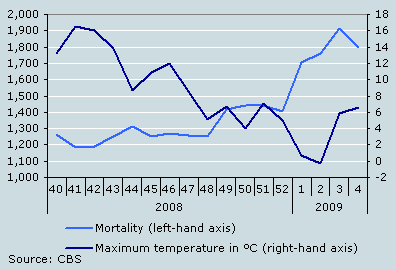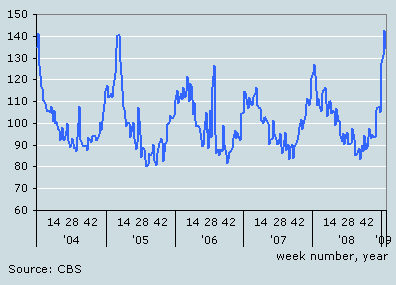More than one thousand cold and flu-related deaths

In the first four weeks of 2009, mortality among the older population was more than one thousand higher than in the preceding years. The extra deaths are caused by a fatal combination of a cold wave and a flu epidemic.
Mortality in the first four weeks

Over one thousand extra deaths
In the first four weeks of this year, 7.2 thousand people in the age category 80 years and older died, an increase by over a thousand compared to the average death toll in this period. The high mortality rate is entirely attributable to a combination of cold weather and influenza, which claimed many victims, particularly in the older population. The first weeks of 2009 were the coldest in twelve years. The number of flu patients was far higher in this period than in previous years.
Weekly mortality among over-80s and temperature

Flu follows cold period
The risk of dying is always considerably higher during cold periods – even if there is no flu epidemic– than in summer. As temperatures plummeted in the first weeks of 2009, the mortality rate in the older population soared. In De Bilt, the maximum daily temperature averaged --0.3 o C in the second week of 2009, the lowest level in six years. Weekly mortality among over-80s was 500 up on the average during last year’s summer period. In the third week of January, temperatures were slightly higher, but the flu epidemic persisted.
In the third week of 2009, mortality in the over-80 population was about 40 percent above the average level. Such a record level is nearly always the result of a combination of a cold period and a flu epidemic. The last time this occurred, was in February/March 2005, when a flu epidemic swept the country and the maximum daily temperature was around freezing point.
Annual mortality pattern among over-80s (average = 100)

Joop Garssen and Carel Harmsen